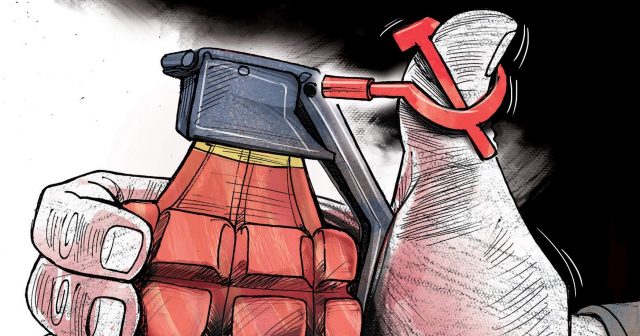
It seems there isn’t enough of a sense of urgency in the country as a whole either to the clouds gathering over our horizon or to the many signs of our being surrounded. If there were, there would have been a countrywide outrage at what happened in Sukma.
True, we did not lack in offering the respect and honour the martyred policemen deserved and Union Home Minister Rajnath Singh himself warned the Naxal leaders that their movement would be made to pay heavily for coercing the villagers to partner them in the attack on the security forces.
Such counter threats would have only limited value in revolutions where the participants are brainwashed to believe that there would be instant salvation under a Maoist rule as against the long-drawn procedures in our system.
The capability of the Naxalites to get to know the movement of the security forces in advance and surprise them by surrounding and killing them en masse was what was demonstrated in Sukma in the Bastar region of Chhattisgarh. Several such incidents including the murders of the state’s political leaders has happened in the same troubled region earlier. Why do such ghastly incidents get repeated regularly?
Both the operational leadership of the security forces and the political leadership in Raipur and New Delhi are yet to convince people that they are not a bunch of lotus eaters but are rising up to the multiple challenges of the well-armed Naxal movement.
The occasional reports we get of some Maoists being captured alive and held outside Bastar are not convincing enough. Going by the responses that have filled social media pages, little attention has been paid to understand the basic causes that turn long suffering but innocent villagers, especially tribals, into devoted Naxal supporters. True, it is the grip of unchallengeable violence that turns the denizens of the mineral-rich forests into obedient Marxists. Reports from Sukma say the brain behind the latest attack is a 32-year-old Naxal leader known as Hidma.
What should be of greater value to those who intelligently track the Naxal movement socially is that Hidma is a tribal belonging to the area. Have we asked the right questions in tracking the roots of the movement that has defied the Indian state all these years, irrespective of the party in power in New Delhi or Raipur?
What is the level of real influence the “elected” MLAs and MPs have? These are all constituencies reserved for tribals.Has any independent research been promoted on the influence these politicians, who are from among the sons of the soil, have on the people? Has any self-examination been done by political parties on the weight they carry in the constituencies they are elected to represent?
And what about the government officers at various levels who get their jobs due to the tribal tag and claim priority because of it? The fact has to be faced that the state apparatus as such does not like journalists who, though they come from outside, succeed in picking up the deeper threads.
From the post-Sukma reports, we see that the Naxals have a whole array of modern weapons including AK-47 guns. Some of these may be weapons that they grabbed from security forces themselves in ambushes.
But the weapons also need auxiliaries. The guns need specialised ammunition. How do these Naxal leaders manage to build up a supply chain and keep it ticking when such a chain has to necessarily run through several states?
The experience of seizures of illegal weapons in Andhra reveals the foreign source of supply with a small portion coming from local gangs engaged in weapon smuggling. But the weapon types used in this attack expose much deeper linkages and sources that connect them to our country’s sworn enemies.
Is Sukma connected to stone-throwing protests in Srinagar? In the records of the government are intelligence reports about select Naxal leaders meeting Kashmiri and Pakistani militants with some specific arrangements existing and regular review going on under the nose of our security establishment.
In Kashmir, infiltrating Pakistan-trained terrorists and local militants provoke events that show the Indian security establishment in bad light. And when Naxal leaders create events that also aim at the security establishment, and many similar incidents occur beyond the eastern borders, can we afford to ignore what looks like a linkage to encircle our country?
Two specific developments should immediately strike us in this context. One is the renewed noise that Beijing is making over the Dalai Lama’s visit to Arunachal Pradesh and the name change of various parts of that state of ours that Beijing has announced as if it is a Chinese territory.
The naval engagements that China is planning in the Indian Ocean should also be read in the context of its big ticket investment of nearly 50 billion dollars in building the transport and industrial corridor linking its southern provinces to the Chinese-built huge port and naval facilities in Gwadar in Pakistan. There cannot be a more explicit statement of China-Pakistan encirclement aimed at our country.
In this, the Naxals with their Maoist ideology and arms supply from outside, the Kashmiri separatists and student jihadis play a vital part. They believe that the weaker the security situation in India gets, the better for them as they can achieve their intentions.
There is a third element—our own Left-liberal bloc. They try to urge the policy makers to ignore the seriousness of Marxist China’s plan for encirclement of India. The ambush in Sukma is yet another more wake-up call.
Balbir Punj
Former Rajya Sabha member and Delhi-based commentator on social and political issues
Courtesy: New Indian Express














